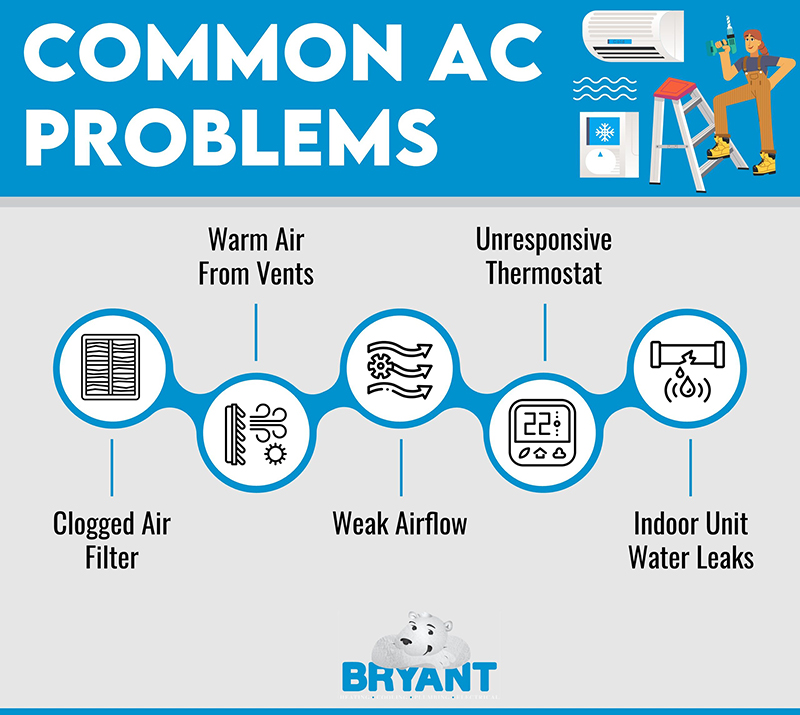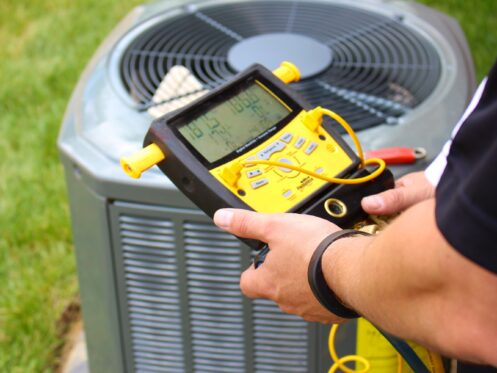If you live in Louisville, KY, your home’s air conditioning unit is vital to your comfort during spring and summer. However, like all appliances and equipment in your home, your air conditioning unit can sometimes experience malfunctions and part failures. Many of the common issues that ACs develop aren’t serious. However, some are serious enough that you shouldn’t continue using your AC while awaiting repairs. Here are five common AC problems, how you can recognize them, and their causes.
1. Clogged Air Filter
One of the most common and preventable AC problems is a clogged air filter. The disposable air filter in the average AC unit requires replacement every 30 to 90 days. After that time, the filter can be so dirty that it obstructs airflow through your system. That problem, on its own, will severely hamper your AC’s cooling capacity.
It will also cause a noticeable increase in your electricity bills. If you don’t replace the filter quickly enough, it can also increase wear and tear and induce part failures. This happens because your AC’s blower fan and other components work harder to overcome air resistance.
You may notice that a clogged air filter results in less air flowing out of your vents. Weak airflow should prompt you to inspect your filter and its housing. In addition to weak airflow, you may also notice warm air coming from your vents.
Your AC’s evaporator coil may have frozen over, hampering heat exchange. This results from a lack of airflow over the coil, which keeps the refrigerant running through it colder for longer periods of time. The abnormally low refrigerant temperatures cause the freezing.
2. Warm Air From Vents
If you have normal airflow volume but the air seems warm, it can suggest a problem other than a clogged filter. The first thing you should check is your thermostat. You may have switched the fan setting on rather than set it to auto. In this instance, your AC’s fan merely cycles warm air through your home. Switching the setting back to auto should correct the problem.
If your thermostat settings appear normal, the next place to look is at your AC’s outdoor unit. If your AC is running, the large fan in the outdoor unit should be running too. If it isn’t, you’ve found the source of your problem.
It usually means that you need a new capacitor. The capacitor provides a necessary power boost when your AC’s large fan starts up. A failed capacitor may also lead to the fan running much slower than usual.

If your AC unit’s fan appears to be working correctly, a refrigerant leak is another possible cause of the warm air. In that case, you should turn off your AC immediately. Running your AC with low refrigerant can cause multiple problems.
One is that your evaporator coil might freeze. That results from the refrigerant’s temperature dropping with its pressure. Another more serious risk is that you could destroy your AC’s compressor. AC refrigerant also carries oil that lubricates the compressor. Running equipment without it may lead to a seized compressor and permanent damage.
3. Cold but Weak Airflow
It is also possible for your AC unit to continue pumping out ice-cold air, but not enough to cool your home. If this happens and your AC air filter isn’t the cause, two other common problems might explain it. The first is an issue with your AC’s blower motor. If it’s not running at full speed, you’ll experience a sharp drop in airflow from all your vents. You may also notice odd sounds coming from your indoor AC unit.
The other problem that can cause cold but weak airflow is an issue with your AC ductwork. If some parts of your home seem more affected than others, that may explain why. As your ductwork ages, its joints can develop holes or weaknesses. This allows conditioned air to escape, leading to poor airflow.
4. Unresponsive Thermostat
Another common AC issue you may experience is an unresponsive thermostat. If your thermostat turns off completely, replacing the battery may solve the problem. If your thermostat draws power from a dedicated power supply, the problem is more complicated.
You may need a new thermostat if your current model is approaching 10 years old or more. It is also possible that your AC’s control circuitry is the problem, or there is an issue with the thermostat’s power wires. It’s wise to let one of our HVAC technicians diagnose and solve the issue to ensure safety and functionality.
Another scenario is when the thermostat’s display works, but your AC doesn’t react to setting changes. The first thing to check is your AC’s circuit breaker. If your AC has no power, it cannot respond when you change the thermostat settings.
An internal thermostat failure is the next likely culprit if the AC has power. In that case, you can replace the thermostat to try to resolve the problem. However, only an AC repair service technician with experience can tell you the exact cause of the issue.
5. Indoor Unit Water Leaks
Finally, you may notice water dripping from your AC’s indoor unit. The condensation dripping from your evaporator coil isn’t draining correctly. Your AC unit extracts moisture from your home’s warm air as it touches the cold evaporator coil. Normally, that condensation drips into a collection pan and drains through a condensate drain line. Some AC units have a small pump that assists in evacuating the moisture.
The most common reason for a condensate leak is a clogged condensate line. The first place to check is at the drain line’s outlet. To find it, follow the PVC pipe leaving your indoor AC unit.
In most installations, the line passes through an exterior wall and drains outside. In some cases, vegetation or debris could block the open end of the line. If this is the case, clear away the obstruction to solve the problem.
If the line looks clear, there are other issues to investigate. A common problem is a clog inside the pipe itself. The other potential cause of the problem is a damaged condensate pan.
This is an issue that typically afflicts older air-conditioning units, as prolonged contact with water leads to corrosion and rust on the pan. When this damage occurs, the water finds somewhere to escape other than through the condensate line. The solution is to have the pan replaced.
Your Local AC Repair Experts
No matter what problem you’re having with your air conditioning equipment, Bryant Heating, Cooling, Plumbing & Electric can help. Our air conditioning services pros have been helping Louisville homeowners for over 85 years. Our HVAC technicians are NATE-certified and qualified to repair air conditioning equipment of any make or model. We can also perform routine AC maintenance to keep your unit running efficiently and reliably throughout the spring and summer months.
If your air conditioning system is past its life expectancy and experiencing frequent problems, let’s talk about having a new unit installed. We’ll ensure you pick the right model, considering your budget, home size, and household cooling needs. If you’re having problems with the AC in your Lexington home, call Bryant Heating, Cooling, Plumbing & Electric today.



